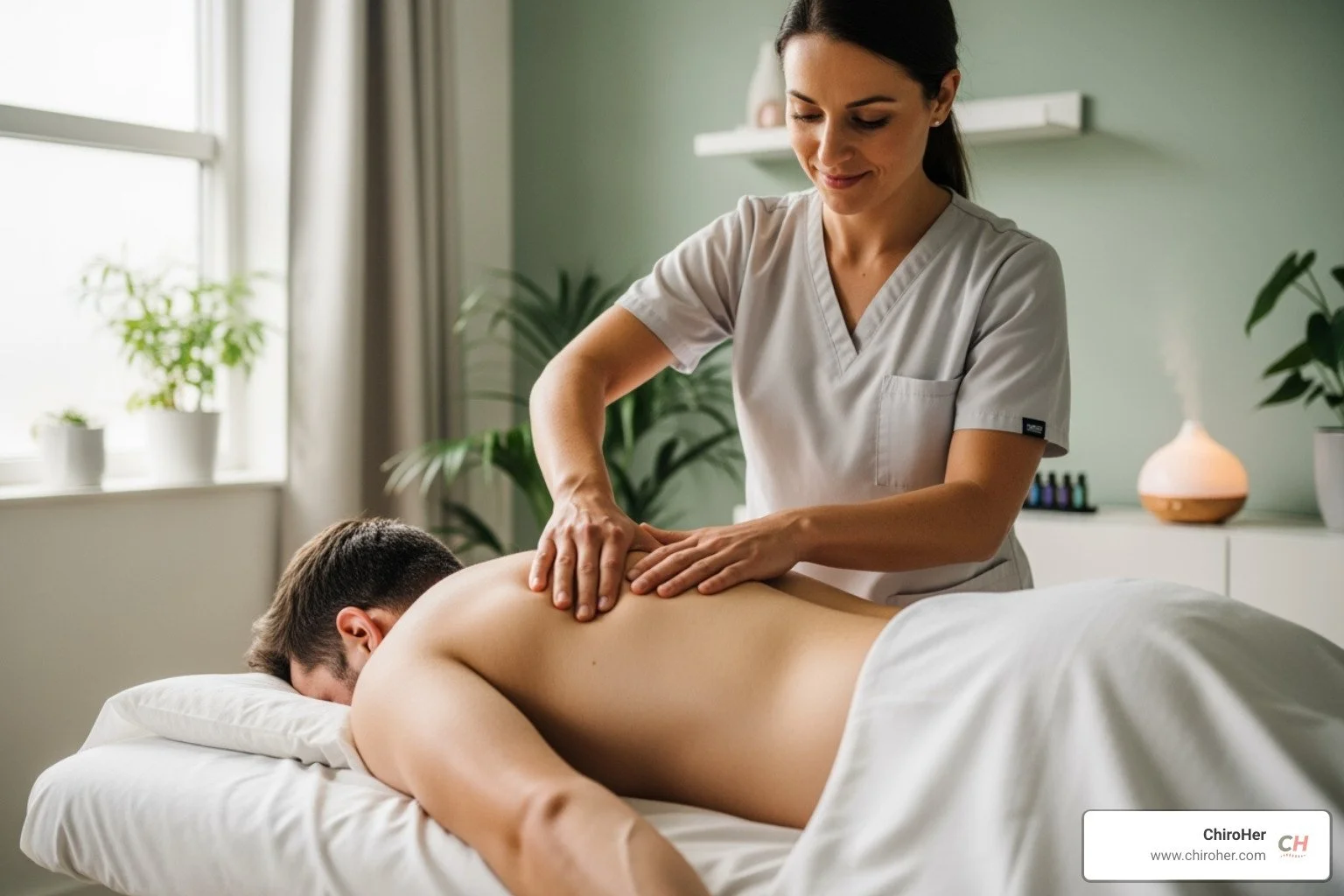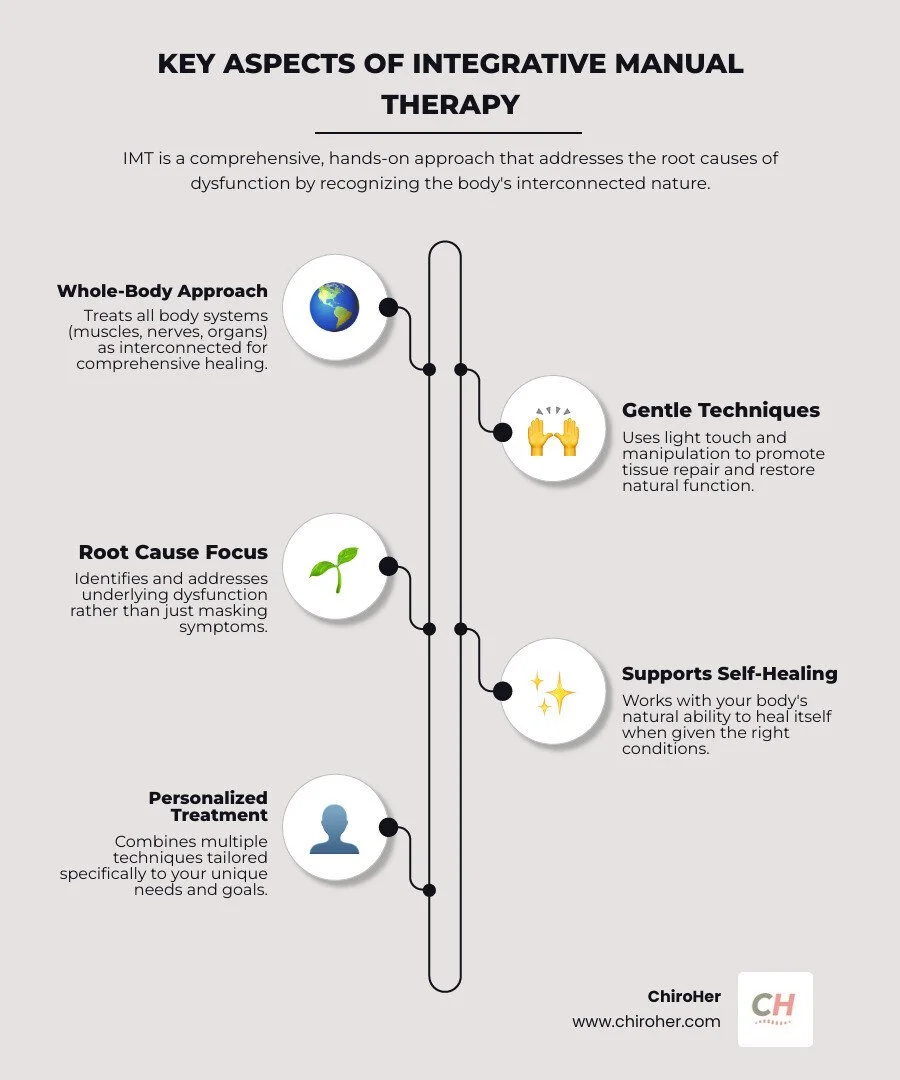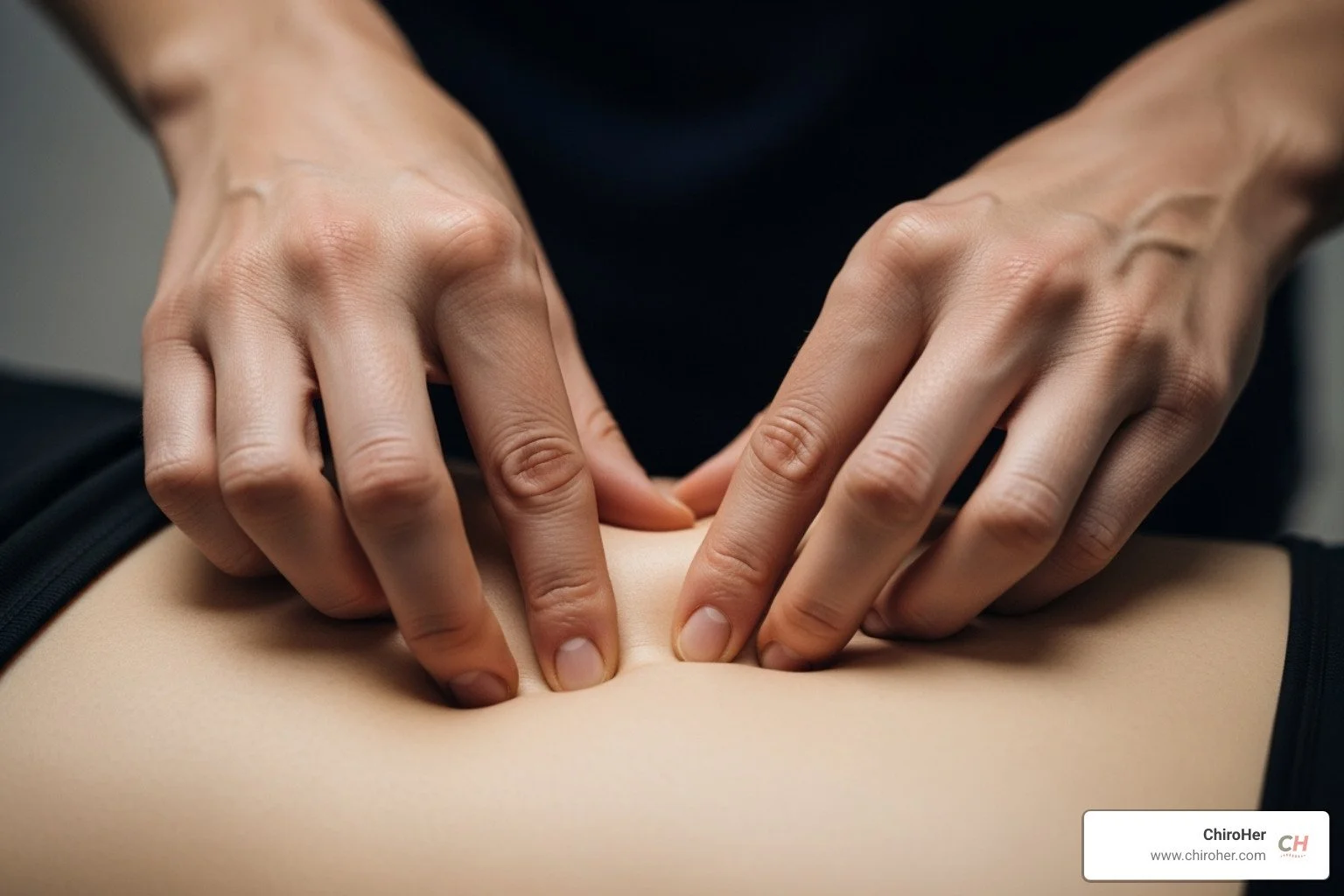Integrative Manual Therapy: What It Is and How It Can Help You
What Integrative Manual Therapy Means for Your Body
What is integrative manual therapy? It is a hands-on approach to wellness that uses gentle techniques to address pain and dysfunction. Unlike approaches that focus on a single area, IMT recognizes that all your body systems are connected and addresses the root causes of your discomfort.
Key aspects of Integrative Manual Therapy:
Whole-body approach - Addresses all body systems (muscles, bones, nerves, organs) as interconnected
Gentle, hands-on techniques - Uses light touch to promote tissue repair and restore function
Root cause focus - Identifies and addresses underlying dysfunction, not just symptoms
Self-healing support - Works with your body's natural ability to heal itself
Personalized care - Combines multiple techniques for your specific needs
IMT practitioners use their hands to feel for restrictions and imbalances throughout your body. From this assessment, they develop a customized care plan using gentle manipulations to restore balance and encourage healing. This therapy can help with chronic pain, headaches, joint problems, and digestive issues, especially if other approaches haven't provided lasting relief.
Hi! I'm Dr. Michelle Andrews, and at ChiroHer, I integrate manual therapy techniques into personalized care plans for busy professionals and moms in Oklahoma City. Understanding what integrative manual therapy is has allowed me to help hundreds of patients find lasting relief from pain while supporting their overall wellness goals.
Understanding Integrative Manual Therapy
Integrative Manual Therapy represents a shift in how we think about healing. We see the body as an interconnected web, not as separate parts. This perspective helps us find the true source of your health concerns. For example, nagging shoulder pain might be related to an old ankle injury. We don't just address where it hurts; we investigate why it hurts.
The Core Principles and Philosophy of IMT
At its core, IMT is built on a trust in your body's natural wisdom. Sometimes, injuries or stress can overwhelm your self-correction systems, and your body needs gentle support to get back on track. The principles that guide our work are simple but powerful:
Your body is one integrated system. Your muscles, bones, nerves, and organs constantly communicate. A restriction in one area can affect another.
Structure affects function. When a joint is stuck or tissue is tight, it can't do its job properly. By restoring normal structure, we help your body function as it should.
Your body has an innate capacity to heal. Our role is to remove obstacles that hinder this natural process.
Care is patient-centered. Your experiences, concerns, and goals matter. We listen and work with you to create a care plan that makes sense for your life.
We find root causes. Pain is your body's way of signaling that something needs attention. We look beneath the surface to provide more lasting relief.
At ChiroHer, these principles are woven into our holistic wellness services, ensuring you receive care that addresses your whole self.
How IMT Works: Assessment and Care Methods
The practice of Integrative Manual Therapy is both an art and a science. Everything starts with our hands. Through specialized training, practitioners develop refined touch skills to feel what's happening deep inside your body.
We begin with a thorough assessment using palpation, our primary assessment tool. With gentle pressure, we feel for restrictions and tension patterns in both superficial and deep tissues. We may also use motility testing to evaluate the natural, subtle rhythm of tissues and organs or muscle response testing to check nervous system function.
Once we understand what's happening, we create a personalized care plan from many gentle techniques, including:
Myofascial release: Applying sustained, gentle pressure to release tension in your fascia, the connective tissue web that wraps around everything in your body.
Cranial therapy: Using extremely light touch on your head and spine to balance your nervous system and release deep tension.
Visceral manipulation: Using gentle, specific touch to restore normal movement to your internal organs, which can relieve pain in your back or shoulders.
Strain-counterstrain: Positioning your body to shorten a tight muscle, which resets its tension and often provides immediate relief.
Muscle energy techniques: Guiding you to use your own gentle muscle contractions to improve joint movement and flexibility.
At ChiroHer, we also offer acupuncture, which works beautifully alongside our manual therapy techniques for pain relief and stress reduction.
IMT Technique Primary Focus Myofascial Release Releasing tension in fascia (connective tissue) Cranial Therapy Balancing the central nervous system, skull, and sacrum Visceral Manipulation Restoring mobility and function of internal organs Strain-Counterstrain Resetting muscle spindles, reducing tender points Muscle Energy Techniques Improving joint motion, muscle length, and strength using patient effort Neural Tissue Technique Mobilizing nerves, releasing adhesions Osteopathic Manipulation Comprehensive musculoskeletal and systemic care Acupuncture Stimulating specific points for pain relief and systemic balance
Conditions and Body Systems Supported by Integrative Manual Therapy
Because IMT addresses your entire body as an interconnected system (musculoskeletal, nervous, visceral, and lymphatic), it can help with a wide range of health concerns. We often find that symptoms in one area are connected to problems somewhere else entirely.
IMT may be helpful for:
Chronic pain, fibromyalgia, and chronic fatigue
Low back pain and sciatica
Headaches (including migraines and tension headaches)
Joint pain in knees, hips, and shoulders
Neck pain and pelvic pain
Digestive issues like IBS
Post-surgical recovery and sports injuries
TMJ dysfunction (jaw pain)
The IMT Practitioner and Integrated Healthcare
IMT practitioners may come from backgrounds in physical therapy, chiropractic, or occupational therapy. At ChiroHer, our chiropractors have completed specialized training in IMT techniques, combining knowledge of spinal biomechanics with a whole-body perspective.
We believe in collaborative care and often work alongside your primary care doctor, physical therapist, or other providers. IMT is designed to complement other medical approaches, not replace them. It is also a powerful tool for prevention and maintaining long-term health, such as during our prenatal chiropractic care.
The Benefits and Evidence Behind IMT
When you ask what is integrative manual therapy and why it matters, the answer lies in how it addresses the underlying causes of your discomfort to create lasting change. Many of our patients at ChiroHer describe it as finally feeling like themselves again.
The Evidence Base: What Research Says About Integrative Manual Therapy
While research on the complete IMT system is still growing, the individual techniques it includes are well-studied, and the results are encouraging.
Effectiveness: Research shows manual therapies can provide improvements in both pain and function for conditions like headaches, fibromyalgia, low back pain, and neck pain.
Clinical Guidelines: Manual therapy is recommended in most clinical guidelines for managing musculoskeletal pain. The National Institute for Health and Care Excellence (NICE), for example, recommends it for low back pain and osteoarthritis.
How It Works: Studies suggest these hands-on techniques can influence inflammation, reduce fibrosis (scar tissue), and impact how pain signals travel through your nervous system. For a deeper scientific perspective, the IASP taskforce viewpoint on integrated manual therapies provides an excellent overview.
Safety: When performed by qualified practitioners, manual therapy is remarkably safe. About 41% of patients experience minor side effects like temporary soreness, but major adverse events are very rare (occurring in only about 0.13% of cases).
Your expectations and the therapeutic relationship we build together also play important roles in your outcomes. That's why we invest time in getting to know you and your goals.
Patient Outcomes and Whole-Person Health
Experiencing the effects of what is integrative manual therapy is about getting back to the life you want to live. This is about more than just numbers on a pain scale. Patients often report a wide range of positive outcomes:
Pain Reduction: Lasting relief from chronic back pain, persistent headaches, and widespread discomfort.
Increased Mobility and Function: The ability to move more freely and perform daily activities without pain, from sitting at your desk to playing with your kids.
Stress Reduction: The gentle, hands-on nature of IMT can calm your nervous system, helping to reduce anxiety and emotional stress stored in the body's tissues.
Faster Recovery: IMT can support recovery from injury or surgery by reducing inflammation and minimizing scar tissue formation.
Improved Overall Wellness: By supporting circulation, immunity, and organ function, IMT contributes to better energy, digestion, and sleep.
At ChiroHer, we take a whole-person approach, which is sometimes called the biopsychosocial model of health. We often incorporate nutritional counseling into care plans, acknowledging that you are more than just a set of symptoms.
Building Trust: Authority and Resources
When you're considering a care approach like what is integrative manual therapy, it's natural to want to know you're in capable, experienced hands. At ChiroHer, we take that responsibility seriously.
Our practitioners bring years of specialized training to every care session. Beyond our foundational chiropractic education, we have invested in advanced certifications and ongoing education in manual therapy techniques. We are committed to staying current with new research and refined techniques to provide the most effective care possible.
What truly sets us apart is our patient-focused philosophy. We take time to listen to your story, understand your unique health challenges, and develop personalized care plans. This attention to detail is why we've earned recognition as an award-winning practice and why patients from Oklahoma City, Yukon, Edmond, and Nichols Hills trust us with their care.
We also believe in empowering you with knowledge. While we guide you through your healing journey, understanding the science behind your care can be valuable. For those who want to explore the broader research on manual therapy, reputable sources like the National Institutes of Health (NIH) and the Mayo Clinic offer extensive, evidence-based information.
Your health deserves practitioners who combine expertise with genuine care and view you as a whole person rather than just a set of symptoms. That's the standard we hold ourselves to at ChiroHer, and it's what you can expect when you walk through our doors.
This guide is for informational purposes and is not a substitute for already established medical advice from your healthcare provider.





